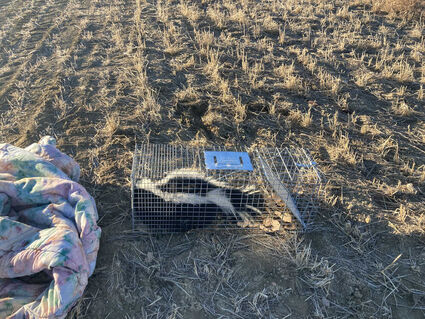Skunks at large in Big Sandy this fall
November 10, 2021
With the arrival of fall the air begins to fill with the signs of the season: crisp frost, the smell of fireplaces in the morning, and the odor of skunks wandering through town. This year is no different, as locals begin smelling and seeing the unwanted neighbors more prominently than normal. Lianna Heimbigner spotted one a few weeks ago outside her home: "(He) came by just after dark when I was letting the dog back in the house from the back door. One of the cats was still sitting outside, when a skunk went walking down the alley, thankfully on the outside of the fence. Luckily, my cat came to me instead of following the skunk and the other cat." Other neighbors have reported seeing them passing through their yards either early in the morning or at sundown. Less lucky members of the community have experienced skunk encounters with their pets. "My husband (Jeremy) and I woke up to our dogs barking in the middle of the night, around 2 AM. We discovered there was a skunk in our backyard and our dog, Cobie, had been sprayed. The smell was so awful and overpowering that we could hardly breathe for the rest of the night. We got our poor sleep and both woke up with headaches," explains Jeanna Echols. Last fall, my family had an encounter with a skunk in the middle of the night when our dog was sprayed in the face trying to chase the intruder off.

The striped skunk, which is common in our area, tends to be more active in the fall in preparation for the winter months. They tend to eat more and develop a layer of fat to sustain themselves. In the fall season, young skunks leave home and find dens of their own. This results in large numbers of the animals spreading out, foraging, and looking for winter accommodations. The drive to find food and new shelter is so strong, the normally nocturnal creatures are sometimes spotted in the daylight. Jeremy Echols told me about encountering a full grown skunk in broad daylight on the west end of town in early November. It was sitting out eating cat food in an overgrown yard next to an unoccupied building.
Dealing with the fallout of the pests' most well known defense mechanism can be a difficult task. Most often, this involves washing your pet thoroughly. The Humane Society recommends you leave the dog outside and wash them there. I can attest that bringing a dog indoors after they've been sprayed can result in a more severe problem. Jeana Echols reported needing to shampoo carpets where the dog had laid down. The Humane Society website also provides an easy recipe for a cleaning solution to use on your pet: 1 quart 3% hydrogen peroxide, 1/4 cup of baking soda, and a teaspoon of liquid dishwashing soap. Wash the animal with the solution and rinse them. Then wash your pet with regular pet shampoo. Check out their website for more information. There are commercially available pet washes, though these products tend to be less available in the late hours when spraying typically takes place.
Ridding your house of the smell can be more challenging. Jeana explained: "It was about a week before we realized the skunk spray incident occurred right outside our son's bedroom window. I then had to wash all of his bedding and clothes to finish getting the skunk smell from our house." When my family had our skunk experience, we were forced to scrub our walls, wash all of our clothes, shampoo the rugs, and spray products designed to neutralize the smell on everything else. We also had some success using an ozone machine in smaller bedrooms.
Perhaps the best strategy for dealing with skunks is to give them no reason to visit your home in the first place. The skunk who sprayed the Echols dog was trying to get into the trash, which is typical of the animal. Skunks are attracted to garbage and carrion. They also love to eat cat food. I have heard more than one report of folks encountering skunks eating cat food they left out for their own pets. In addition to not leaving food out, you can discourage them from visiting your home by spreading out animal repellant products available at most hardwire stores. I got mine at North 40. It was a mix of capsaicin, pepper, and other strong smelling materials. I also spread mothballs out in the yard, which is a tip I spotted on several gardening websites. Live traps are another way of dealing with skunks, which tend to create dens underneath old houses, barns, junk cars, etc. On advice from a friend, I used marshmallows to bait my live trap, which works well because it attracts the animals but will not attract cats. That was how I got a call from my wife last week alerting me to the captured skunk in our field. Live traps have been used successfully to eradicate nests of skunks around town in the past.

